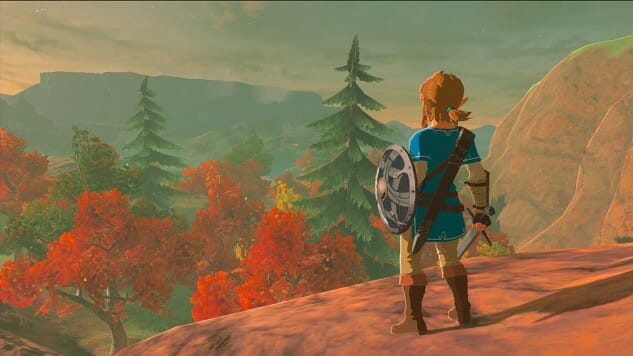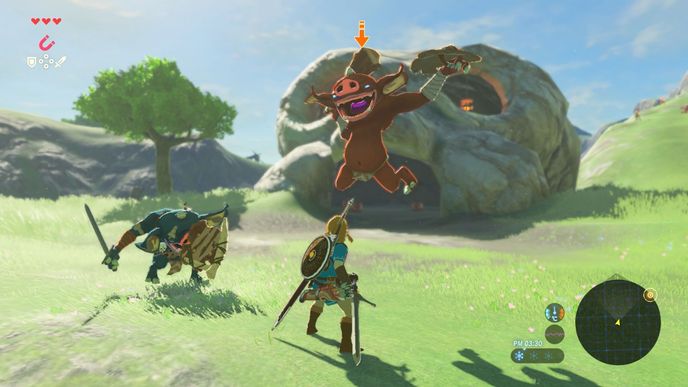The Legend of Zelda: Breath of the Wild Teems with Life and Mystery
Games Reviews The Legend of Zelda
The Legend of Zelda: Breath of the Wild feels alive in a way few games do.
Its massive landmass is covered with a variety of critters, both deadly and peaceful, all tending to their own business until you inevitably intrude hard upon nature. Passersby drip along the trails, most friendly and inquisitive, a few trying to trick you into danger. Towns and stables periodically pop up on the horizon, offering a brief respite from whatever quest you’re currently pursuing. The clock constantly ticks, the sun and moon circling around the globe, the weather sliding from calm to tumult and back again. This Hyrule has presence.
None of this is new in games, but rarely does life pass so organically in these digital realms. True, these characters don’t age, no matter how many days pile up, and their vocabulary is generally limited to a handful of phrases, in the truest RPG tradition, but they don’t feel like scraps of code that only snap to life when they enter your field of vision. They don’t come off as digital homunculi running a preprogrammed circuit. You can easily imagine them having conversations and adventures while you’re doing something unrelated on the opposite side of the continent.
More vibrant still is the world itself, with its variety of mysteries and curiosities. Like the best Zelda games, Breath of the Wild is suffused with unexpected and unusual experiences. You’ll be struggling through a desert ravine when suddenly a bright red dragon soars majestically through the sky above you, completely oblivious to your presence. You’ll be standing on a mountain on the edge of existence when you notice what looks like a humongous metallic maze hovering in midair off in the distance. Early on you’ll be tasked with finding specific locations based solely on photographs and unknowable alien script, and the resolution won’t come for potentially dozens of hours. This isn’t a robotic city from an open-world crime bore, or a detailed recreation of a centuries-old civilization that exists solely to give you busywork. It’s a world that almost seems autonomous in its systems, and which often feels indifferent to your place within it, even as you save it by gradually ticking objectives off a list.
That indifference and the overwhelming amount of things you can do in this world combine to create a bewitching aimlessness. You can pursue the quickest path to victory, but that route doesn’t even become apparent for the first few hours, and the game will constantly try to entice you down tributaries and back alleys. You can easily wind up in areas full of enemies far more advanced than you, that can kill you with a single blow. Link can scurry up cliffs, trees and walls, collecting fruits and bugs, focusing on anything except the task at hand. Even if you avoid all the distractions, you’ll still idle away many hours simply traveling from one point to another. This world won’t let you forget that you’re in it.
That aimlessness isn’t unusual for a Zelda game. Indeed, the best examples are partially defined by it. When done well, it’s a unique formula that continually pushes the player forward despite rarely creating any sense of urgency or pressure. The best Zelda games enshroud a clear central path with mystery better than any other game, spreading a discernible chain of goals throughout a world teeming with odd and enchanting distractions. Breath of the Wild might do this better than any of its ancestors.
Even a spell this ably crafted has cracks, though. Those who bemoan the Ubisoft school of climbing towers to expand the map might be upset to see Breath of the Wild wholeheartedly embrace that model. That map isn’t subsequently littered with icons and blinking hotspots, but it does constantly nudge you towards the right direction.
In an uncharacteristic stab at reality, Link’s weapons are no longer permanent. You’ll regularly scrounge up arms, stealing them from fallen foes or from random treasure chests, and at some point they almost all eventually shatter after one last powerful blow. You’ll also collect shields and bows that all perish over time, build a whole wardrobe full of armor and clothes with different boons, and cultivate a variety of plants, animals and monster organs that are used to cook meals and craft elixirs. It might be the biggest divergence yet from the Zelda norm, and the closest these games have come to the wide-ranging upgrades of a Final Fantasy.
You’ll lose track of how many times those weapons splinter at inopportune moments, or when you lose a shield in the middle of a battle where defense is key. It’s a new set of complications that brings Zelda closer in line with some of the more recent RPG hits it’ll wind up being compared to, but weapons break so quickly that it becomes more of a nuisance than it should be. It’s incredibly easy to find new weapons—indeed, weapons are easier to come by than rupees in this new Hyrule—but none of them ever last quite as long as you expect them to. And with limited inventory slots that can only be upgraded at sporadic moments, you’ll start juggling your supply early in the game.
These grittier footnotes serve as a counterpoint to the fantastical realm of mystery that the game is set in, but they don’t spoil the atmosphere. Forget the goals and sidequests, the collectibles and perishables: what matters is the mise-en-scène. Unlike some of the more recent Zelda games, which were content to reshuffle the deck constructed by Ocarina of Time, Breath of the Wild is a marked diversion from the familiar template. It’s not a complete break—it is undeniably, irredeemably a Zelda game—but for the first time since Wind Waker it expands on what the words “a Zelda game” can mean.
I’ve been editing Paste’s games section long enough that this is the second mainline Zelda game I’ve had the opportunity to review. While discussing Skyward Sword in 2011 I wrote that “it might be time to strike out…and let Link forge a new path.” That’s basically what Breath of the Wild accomplishes: it’s a fresh approach to what Zelda games have striven for since the very beginning. The depth you expect, the open exploration and constant sense of discovery the series is known for, are here in perhaps greater effect than ever before, but with the systems and mechanics that drive the moment-to-moment action heavily overhauled. The result is a Zelda that feels unmistakably like a Zelda, but that also breathes new life into the venerable classic. It’s too early to fully weigh it against the historical record, but if forced to rank the entire coterie of Zelda games, Breath of the Wild would come in near the very top.
The Legend of Zelda: Breath of the Wild was developed and published by Nintendo. Our review is based on the Nintendo Switch version. It is also available for the Wii U.
Garrett Martin edits Paste’s games, comedy and wrestling sections. He’s on Twitter @grmartin.
